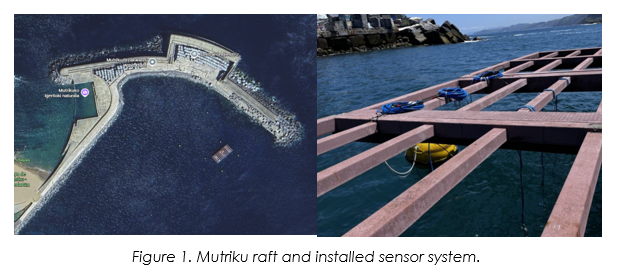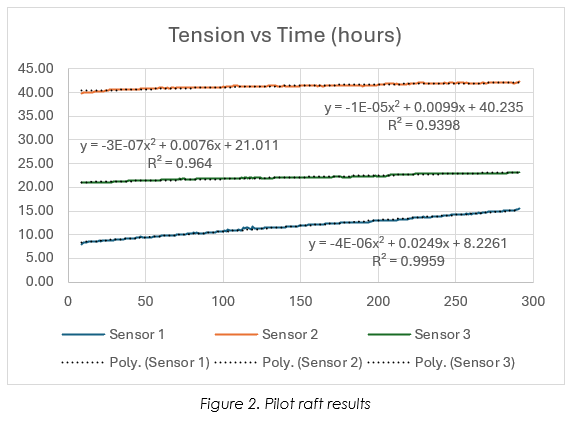OPERATIONAL MONITORING AT AN AQUACULTURE FACILITY
Introduction:
The advancement of offshore aquaculture has necessitated the development of robust and resilient infrastructures capable of enduring variable and harsh marine environments. Nonetheless, significant concerns persist regarding the efficacy of current conventional system designs, monitoring protocols, and maintenance strategies, primarily due to frequent mooring system failures and structural deformations induced by the synergistic effects of hydrodynamic forces such as currents, wave action, and wind loads.
The AQUAMOORE project, funded by INFO Región de Murcia, seeks to address these challenges through the engineering and deployment of an advanced sensor network integrated with a data analytics framework on a mussel longline platform. This system facilitates continuous real-time monitoring of both structural integrity and environmental parameters, enabling early detection of potential failure modes and risk scenarios. Moreover, it supports the implementation of predictive maintenance strategies grounded in numerical simulations, alongside growth modeling to optimize mussel production.
Materials and methods:
A load sensor system with satellite data transmission was installed for continuous monitoring of tensions in production ropes, alongside a current meter to assess sea state conditions.
The working methodology comprised the development of an analytical tool, the execution of seakeeping simulations, and the creation of a machine learning model and digital twin for tension prediction. All results were compared and validated against data collected by the sensor system on two selected days representing storm and calm sea conditions.
This process was initially developed through a simple pilot based on the mooring of a buoy to validate the methodology by studying the correlation between models. Subsequently, the described methodology was applied in a pilot project involving AZTI’s mussel raft located in Mutriku (Basque Country, Spain) (Figure 1), aimed at determining tension in three production ropes and assessing the effect of current on these parameters, thereby enabling estimation of biomass at any given time. Two of the ropes were loaded with known deadweights, while the third carried mussels.
Results:
The results obtained from the various tools in the buoy pilot validated the implemented methodology. The average stress values (mean tension) from the time series collected by the sensors and numerical simulations were comparable and of the same order of magnitude, with errors below 13%. Additionally, the machine learning model showed a correlation coefficient of R² = 0.834 relative to the tension measured by the sensors.
Regarding the mussel raft pilot, the conducted study enabled precise characterization of the stresses experienced by three installed production lines. Through analytical, numerical, and experimental methodologies, simulation models were successfully validated against real sensor data. The analytical tool proved effective in estimating tensions under moderate current conditions. However, the machine learning model did not achieve a valid correlation, as current was the sole input variable, which proved insufficiently representative at the raft’s location.
The sensor data indicate a progressive increase in load on the mussel line, reflecting the expected biomass growth. In contrast, the lines equipped with deadweights exhibited lower and more consistent load values, potentially attributed to the accumulation of biofouling over time.
Conclusion and future work:
The results from the buoy pilot validated the working methodology proposed in the project.
The data collected from the mussel raft demonstrated the feasibility of measuring the tension exerted on the production line. Furthermore, the equations derived for each line confirmed the validity of the system, as the extrapolated values at X = 0 closely matched the initial wet weight of each line. The analytical tools and numerical simulations yielded satisfactory results, whereas the machine learning model did not achieve a strong correlation, primarily due to the minimal current observed in the raft’s environment, and therefore its lack of representativeness, being the sole variable of the model.
Subsequently, the tension measurement system for weight estimation will be deployed on a longline, where current is expected to have a greater influence on the production lines and additional variables, such as wave loads, will also be monitored.
This new deployment aims to decouple the contribution of current to the measured tension in each line and to estimate the biofouling accumulation rate. Ultimately, this will enable accurate estimation of the biomass present on each line. The resulting data will be compared with a study conducted by AZTI in 2024 [1] on mussel growth in this type of production system.
Reference
[1] Arantzamendi et al, 2024, July. Assessing the mechanical properties of biobased versus fossil-based ropes and their impact on the productivity and quality of mussel (Mytilus galloprovincialis) in longline aquaculture: Toward decarbonization

